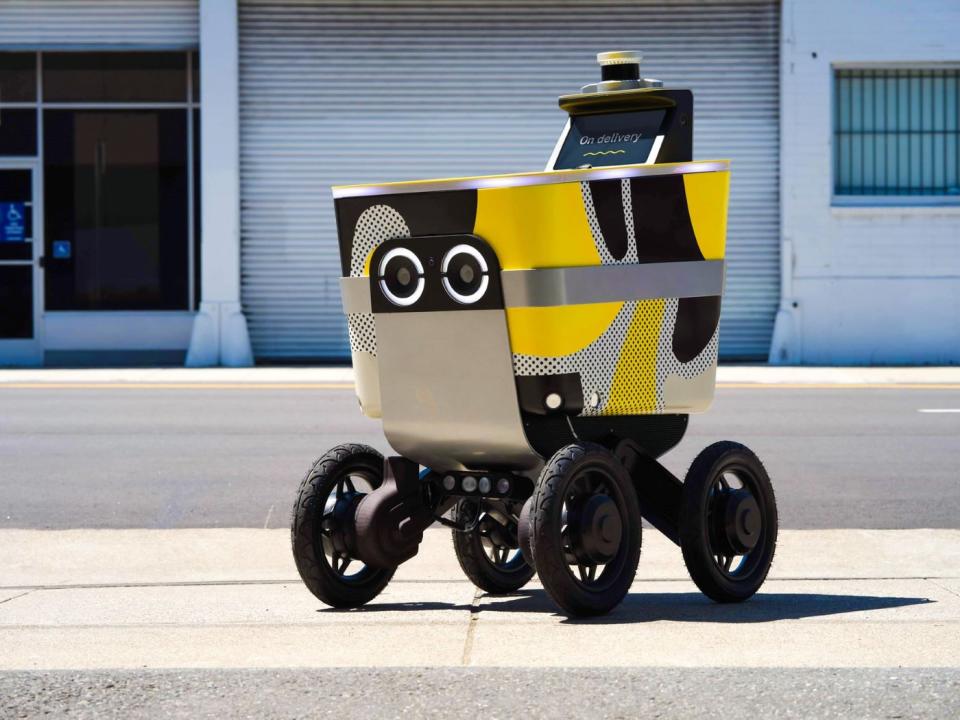Shares of Serve Robotics (NASDAQ: SERV), an autonomous sidewalk delivery company, soared 187% on Friday after artificial intelligence (AI) chip leader Nvidia disclosed via a filing with the Securities and Exchange Commission (SEC) that it owns a 10% stake in the relatively new public company. More specifically, Nvidia owns 3,727,033 shares of Serve’s 37.1 million shares outstanding.
Serve Robotics stock continued its rise on Monday, with its 16.2% gain bringing its two-market-day surge to 233%.
Serve Robotics held its initial public offering (IPO) on the Nasdaq on April 18, 2024, at $4 per share. Shares closed on Monday at $8.77, up from $2.63 on Thursday before the Nvidia news broke. Prior to its Nasdaq listing, Serve’s stock had traded on the OTCQB, the over-the-counter market known as the “Venture Market.”
Should you follow Nvidia’s lead and buy Serve Robotics stock?

Serve Robotics’ background
Serve Robotics — headquartered in California’s Silicon Valley — was originally part of food-delivery company Postmates. In 2021, Serve was spun off from ride-hailing specialist Uber Technologies following Uber’s 2020 acquisition of Postmates.
What does Serve Robotics do?
Serve Robotics develops and operates AI-powered, low-emissions sidewalk delivery robots that serve people in public spaces. The company currently focuses on last-mile food delivery in cities for enterprise partners. Serve’s CEO has said the company eventually plans to expand into grocery, pharmacy, cannabis, and parcel delivery.
In 2020, Serve, which was then a team working for Postmates, launched its sidewalk delivery robots in Los Angeles during the COVID-19 pandemic shutdowns. By the end of that year, its robots had completed over 10,000 deliveries.
After spinning off from Uber in 2021, Serve Robotics formed a partnership with Uber. In early 2022, it began deliveries for Uber on a small scale, and in June of the same year, the two companies signed an agreement for Serve to deploy up to 2,000 of its robots on the Uber Eats platform across multiple U.S. markets.
Serve’s current fleet consists of over 100 robots, it said in a July SEC filing. The company has platform-level integrations with the Uber Eats division of Uber and convenience store chain 7-Eleven. It’s also conducted pilots for Walmart, a major pizza quick-service restaurant, and a major coffee shop chain, according to the filing.
In late April, Serve expanded its existing agreement with Magna International, a leading automotive supplier. Under the new agreement, Magna became the exclusive contract manufacturer of Serve’s delivery robots. In February, Serve had granted Magna a non-exclusive license to its technologies and expertise.
Serve Robotics’ financials
As of Monday’s market close, Serve Robotics’ market cap was $325 million, which makes its stock a small-cap stock.
In the first quarter of 2024, the company’s revenue was $946,711, up from $40,252 in the year-ago period. This big increase was due primarily to about $850,000 in revenue generated from the company’s software services contract with Magna. It also had slightly more revenue from deliveries and branding.
Its Q1 2024 net loss was $9 million, or $0.37 per share, compared with a net loss of $5.1 million, or $0.77 per share, in the year-ago quarter. (The loss per share decreased because of the increase in the number of shares.)
For the full year 2023, the company generated revenue of $207,545 and had a net loss of $24.8 million.
Liquidity is often a huge concern for early-stage tech companies that are not profitable. Indeed, Serve Robotics used cash of $4.1 million running its operations in the first quarter, and ended the period with just $430,000 in cash and cash equivalents. The company’s coffers got a much-needed injection of cash from its April IPO, which netted it cash of $35.7 million. That brought its cash and cash equivalent position up to about $36.1 million.
How long will that $36.1 million in cash last? It’s not possible to estimate because the company said it planned to use some of the IPO cash to scale up its operations. So, investors can probably expect its cash-burn rate to increase. In other words, while it burned through cash of $4.1 million running its operations in Q1 (which equates to an annual operating cash-burn run rate of just over $16 million), this number will likely be higher in Q2 and beyond.
Serve Robotics is a risky stock
Serve Robotics stock is too risky for most investors. It’s only suitable for folks comfortable with buying stock in start-ups that are likely to be unprofitable for a good number of years. Another notable risk factor is the company’s high customer concentration. In Q1 2024, one customer accounted for 90% of Serve’s revenue, it said in an SEC filing. It’s safe to assume this customer is Uber.
Nvidia stock is a better way to invest in robotics
More advanced robots are coming, thanks in large part to recent advances in AI. A solid way to invest in robotics is to buy Nvidia stock. The company’s graphics processing units (GPUs) and related technology are being used for training and deploying autonomous machines of various types, including robots.
Indeed, it’s safe to assume that Serve Robotics is one such company using Nvidia’s GPUs. In a July SEC filing, Serve said, “Nvidia is an early technology collaborator of Serve. We have worked with Nvidia’s robotics and engineering teams for over five years.”
Should you invest $1,000 in Serve Robotics right now?
Before you buy stock in Serve Robotics, consider this:
The Motley Fool Stock Advisor analyst team just identified what they believe are the 10 best stocks for investors to buy now… and Serve Robotics wasn’t one of them. The 10 stocks that made the cut could produce monster returns in the coming years.
Consider when Nvidia made this list on April 15, 2005… if you invested $1,000 at the time of our recommendation, you’d have $722,626!*
Stock Advisor provides investors with an easy-to-follow blueprint for success, including guidance on building a portfolio, regular updates from analysts, and two new stock picks each month. The Stock Advisor service has more than quadrupled the return of S&P 500 since 2002*.
*Stock Advisor returns as of July 22, 2024
Beth McKenna has positions in Nvidia. The Motley Fool has positions in and recommends Nvidia, Uber Technologies, and Walmart. The Motley Fool recommends Magna International. The Motley Fool has a disclosure policy.
Nvidia’s Ownership Stake News Sent Serve Robotics Stock Soaring 233%. Should You Also Buy This AI Stock? was originally published by The Motley Fool
EMEA Tribune is not involved in this news article, it is taken from our partners and or from the News Agencies. Copyright and Credit go to the News Agencies, email news@emeatribune.com Follow our WhatsApp verified Channel





